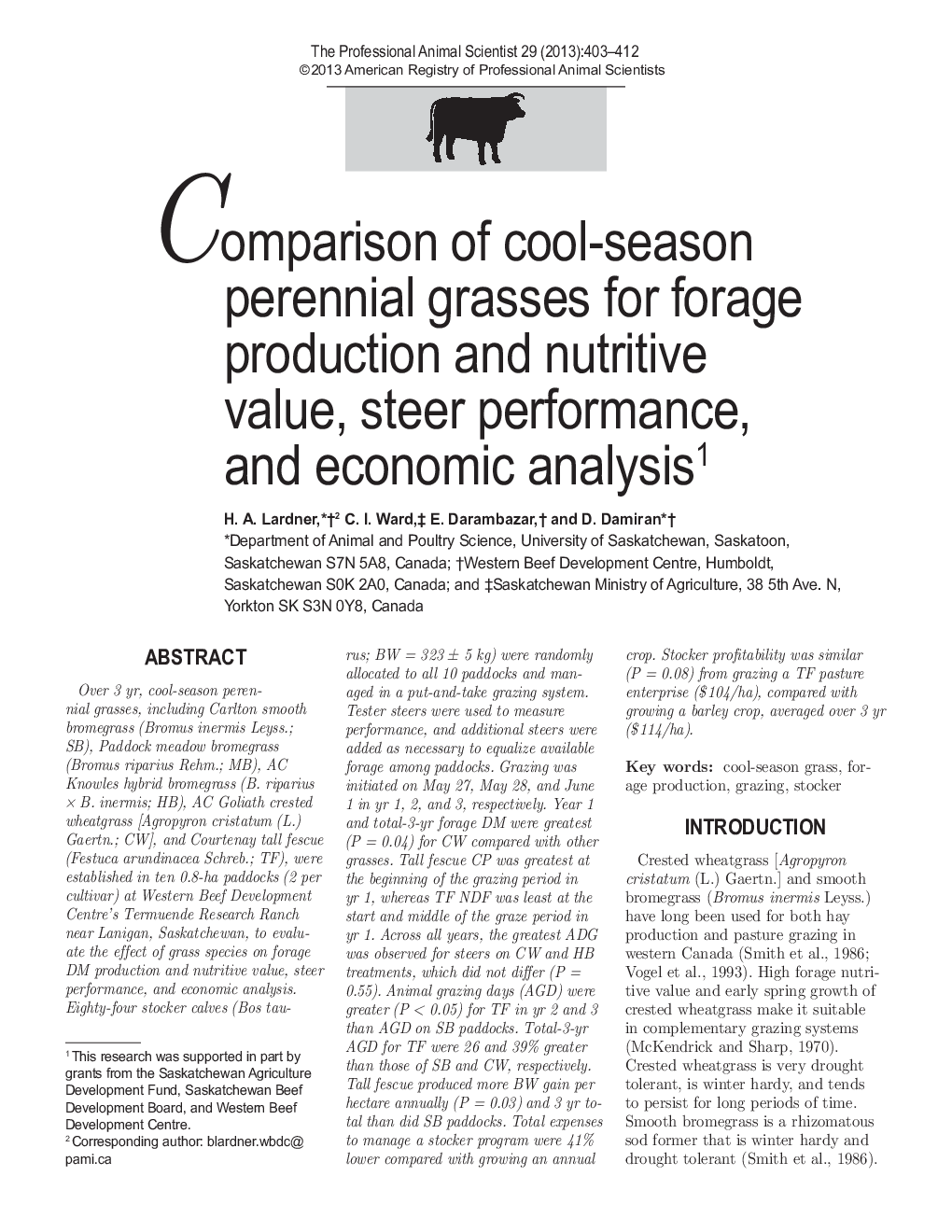| کد مقاله | کد نشریه | سال انتشار | مقاله انگلیسی | نسخه تمام متن |
|---|---|---|---|---|
| 2453973 | 1110362 | 2013 | 10 صفحه PDF | دانلود رایگان |
عنوان انگلیسی مقاله ISI
Comparison of cool-season perennial grasses for forage production and nutritive value, steer performance, and economic analysis1
دانلود مقاله + سفارش ترجمه
دانلود مقاله ISI انگلیسی
رایگان برای ایرانیان
موضوعات مرتبط
علوم زیستی و بیوفناوری
علوم کشاورزی و بیولوژیک
علوم دامی و جانورشناسی
پیش نمایش صفحه اول مقاله

چکیده انگلیسی
Over 3 yr, cool-season perennial grasses, including Carlton smooth bromegrass (Bromus inermis Leyss.; SB), Paddock meadow bromegrass (Bromus riparius Rehm.; MB), AC Knowles hybrid bromegrass (B. riparius à B. inermis; HB), AC Goliath crested wheatgrass [Agropyron cristatum (L.) Gaertn.; CW], and Courtenay tall fescue (Festuca arundinacea Schreb.; TF), were established in ten 0.8-ha paddocks (2 per cultivar) at Western Beef Development Centre's Termuende Research Ranch near Lanigan, Saskatchewan, to evaluate the effect of grass species on forage DM production and nutritive value, steer performance, and economic analysis. Eighty-four stocker calves (Bos taurus; BW = 323 ± 5 kg) were randomly allocated to all 10 paddocks and managed in a put-and-take grazing system. Tester steers were used to measure performance, and additional steers were added as necessary to equalize available forage among paddocks. Grazing was initiated on May 27, May 28, and June 1 in yr 1, 2, and 3, respectively. Year 1 and total-3-yr forage DM were greatest (P = 0.04) for CW compared with other grasses. Tall fescue CP was greatest at the beginning of the grazing period in yr 1, whereas TF NDF was least at the start and middle of the graze period in yr 1. Across all years, the greatest ADG was observed for steers on CW and HB treatments, which did not differ (P = 0.55). Animal grazing days (AGD) were greater (P < 0.05) for TF in yr 2 and 3 than AGD on SB paddocks. Total-3-yr AGD for TF were 26 and 39% greater than those of SB and CW, respectively. Tall fescue produced more BW gain per hectare annually (P = 0.03) and 3 yr total than did SB paddocks. Total expenses to manage a stocker program were 41% lower compared with growing an annual crop. Stocker profitability was similar (P = 0.08) from grazing a TF pasture enterprise ($104/ha), compared with growing a barley crop, averaged over 3 yr ($114/ha).
ناشر
Database: Elsevier - ScienceDirect (ساینس دایرکت)
Journal: The Professional Animal Scientist - Volume 29, Issue 4, August 2013, Pages 403-412
Journal: The Professional Animal Scientist - Volume 29, Issue 4, August 2013, Pages 403-412
نویسندگان
H.A. Lardner, C.I. Ward, E. Darambazar, D. Damiran,